E-Portfolio: Nursing Student's Journey, Goals, and Professional Growth
VerifiedAdded on 2023/05/28
|16
|4552
|383
Project
AI Summary
This e-portfolio presents a nursing student's comprehensive reflection on their career journey and aspirations. It begins with an introduction to e-portfolios, detailing their benefits for students and professionals. The student's resume highlights their educational background and ambitions to become a registered nurse and eventually a nurse practitioner in Australia. The portfolio further explores the student's personal feelings about their new environment and outlines their nursing philosophies, emphasizing patient-centered care, accountability, respect, and continuous learning. Additionally, the document includes a discussion of the student's hobbies and how they contribute to their ability to provide culturally competent care. The portfolio also details short-term and long-term goals and concludes with an action plan, serving as a reflective tool for professional growth and development.
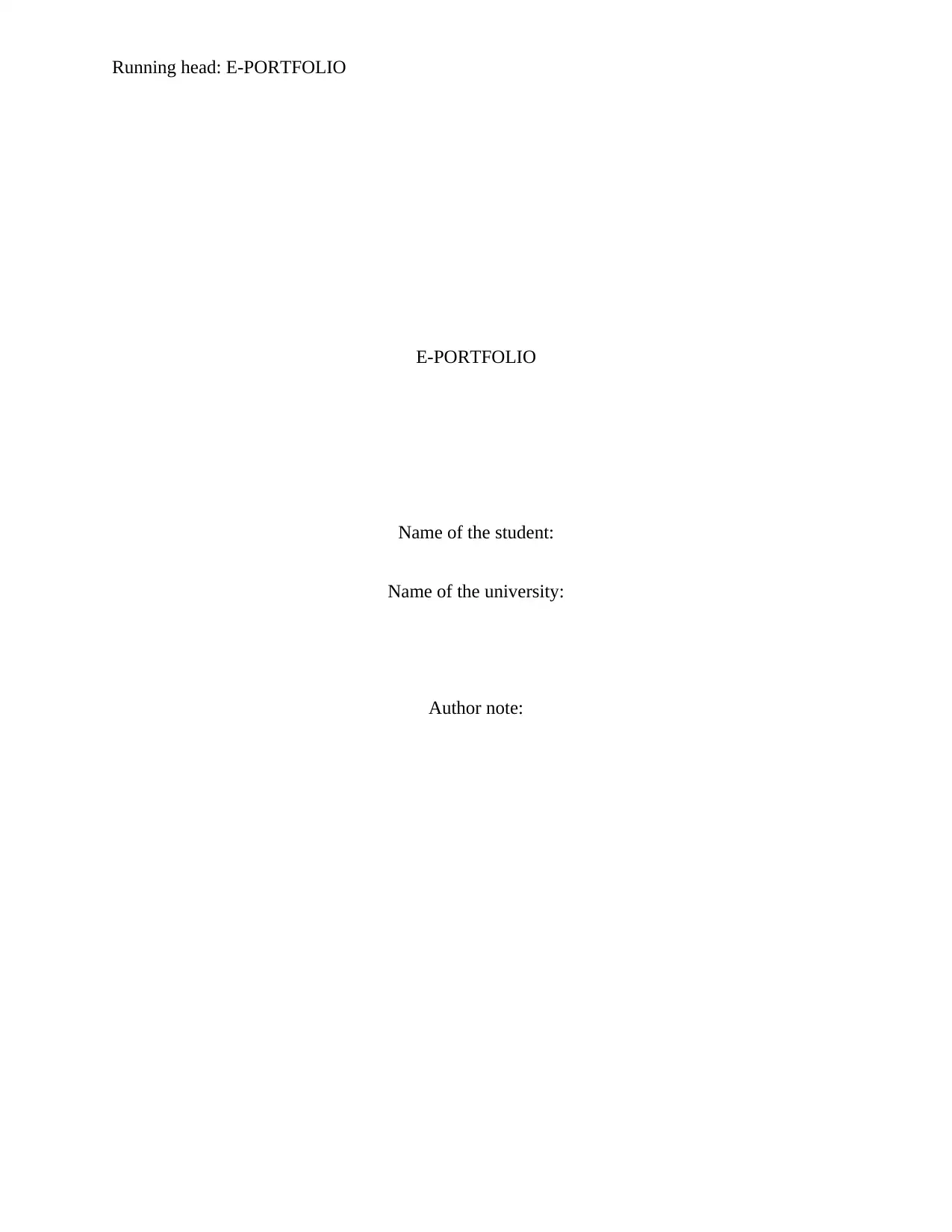
Running head: E-PORTFOLIO
E-PORTFOLIO
Name of the student:
Name of the university:
Author note:
E-PORTFOLIO
Name of the student:
Name of the university:
Author note:
Secure Best Marks with AI Grader
Need help grading? Try our AI Grader for instant feedback on your assignments.
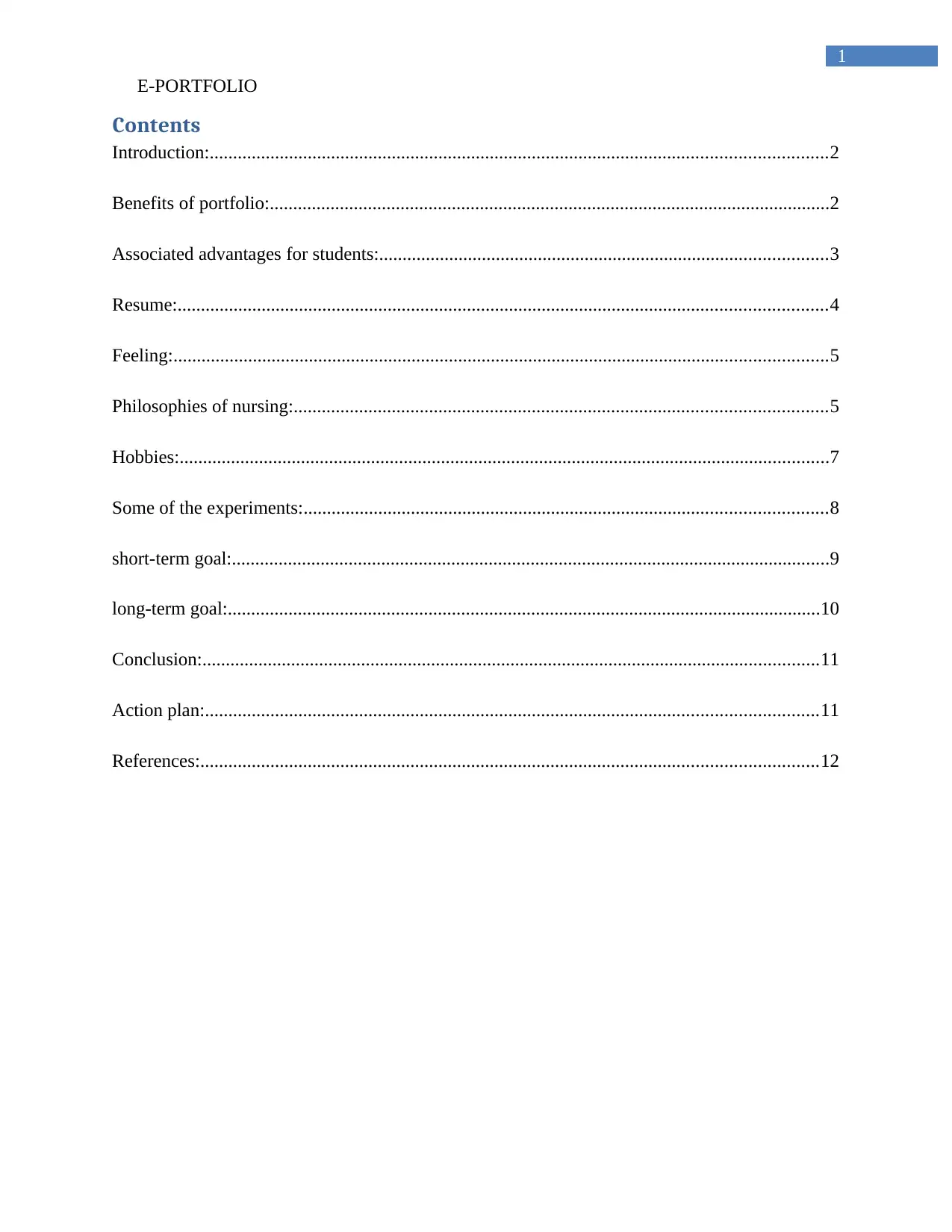
1
E-PORTFOLIO
Contents
Introduction:....................................................................................................................................2
Benefits of portfolio:........................................................................................................................2
Associated advantages for students:................................................................................................3
Resume:...........................................................................................................................................4
Feeling:............................................................................................................................................5
Philosophies of nursing:..................................................................................................................5
Hobbies:...........................................................................................................................................7
Some of the experiments:................................................................................................................8
short-term goal:................................................................................................................................9
long-term goal:...............................................................................................................................10
Conclusion:....................................................................................................................................11
Action plan:...................................................................................................................................11
References:....................................................................................................................................12
E-PORTFOLIO
Contents
Introduction:....................................................................................................................................2
Benefits of portfolio:........................................................................................................................2
Associated advantages for students:................................................................................................3
Resume:...........................................................................................................................................4
Feeling:............................................................................................................................................5
Philosophies of nursing:..................................................................................................................5
Hobbies:...........................................................................................................................................7
Some of the experiments:................................................................................................................8
short-term goal:................................................................................................................................9
long-term goal:...............................................................................................................................10
Conclusion:....................................................................................................................................11
Action plan:...................................................................................................................................11
References:....................................................................................................................................12
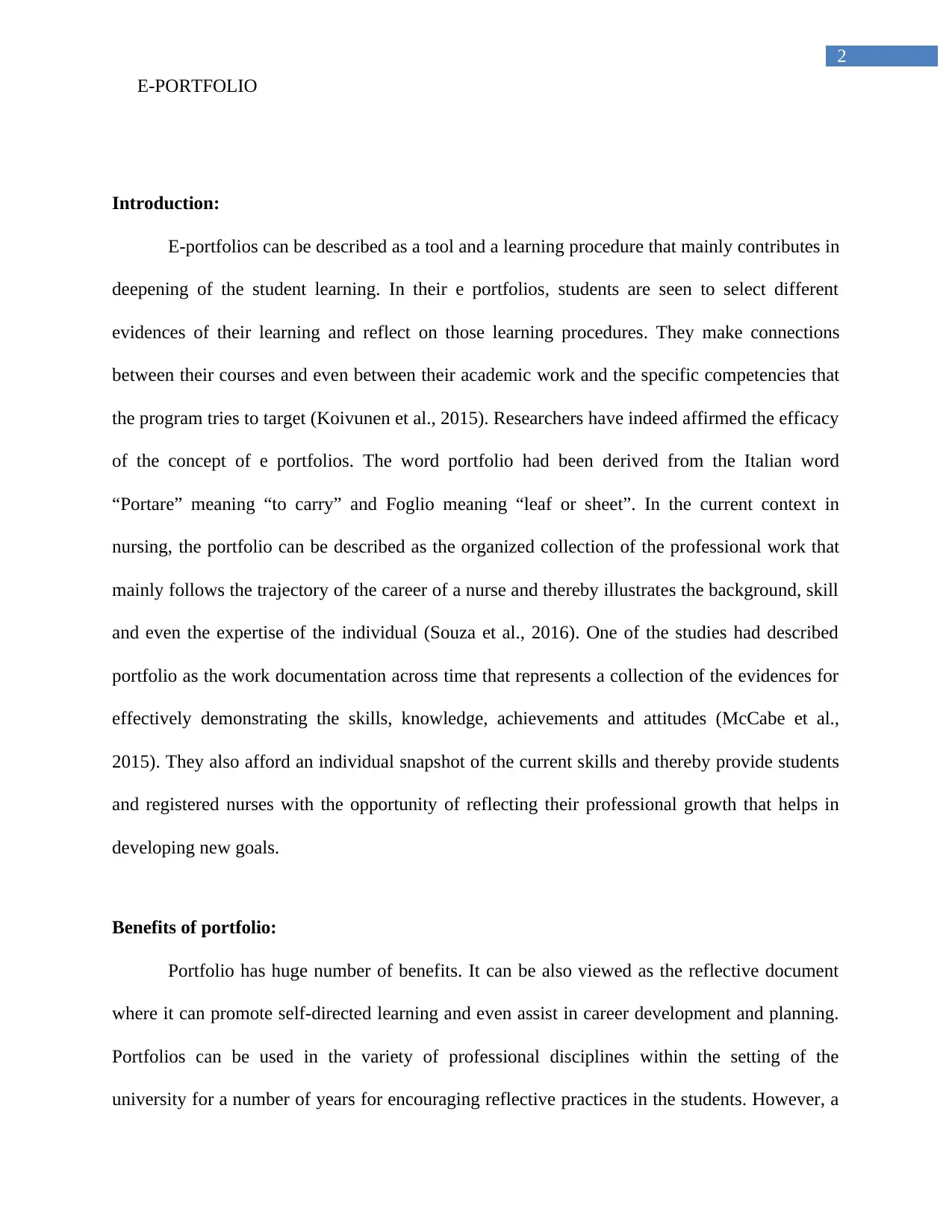
2
E-PORTFOLIO
Introduction:
E-portfolios can be described as a tool and a learning procedure that mainly contributes in
deepening of the student learning. In their e portfolios, students are seen to select different
evidences of their learning and reflect on those learning procedures. They make connections
between their courses and even between their academic work and the specific competencies that
the program tries to target (Koivunen et al., 2015). Researchers have indeed affirmed the efficacy
of the concept of e portfolios. The word portfolio had been derived from the Italian word
“Portare” meaning “to carry” and Foglio meaning “leaf or sheet”. In the current context in
nursing, the portfolio can be described as the organized collection of the professional work that
mainly follows the trajectory of the career of a nurse and thereby illustrates the background, skill
and even the expertise of the individual (Souza et al., 2016). One of the studies had described
portfolio as the work documentation across time that represents a collection of the evidences for
effectively demonstrating the skills, knowledge, achievements and attitudes (McCabe et al.,
2015). They also afford an individual snapshot of the current skills and thereby provide students
and registered nurses with the opportunity of reflecting their professional growth that helps in
developing new goals.
Benefits of portfolio:
Portfolio has huge number of benefits. It can be also viewed as the reflective document
where it can promote self-directed learning and even assist in career development and planning.
Portfolios can be used in the variety of professional disciplines within the setting of the
university for a number of years for encouraging reflective practices in the students. However, a
E-PORTFOLIO
Introduction:
E-portfolios can be described as a tool and a learning procedure that mainly contributes in
deepening of the student learning. In their e portfolios, students are seen to select different
evidences of their learning and reflect on those learning procedures. They make connections
between their courses and even between their academic work and the specific competencies that
the program tries to target (Koivunen et al., 2015). Researchers have indeed affirmed the efficacy
of the concept of e portfolios. The word portfolio had been derived from the Italian word
“Portare” meaning “to carry” and Foglio meaning “leaf or sheet”. In the current context in
nursing, the portfolio can be described as the organized collection of the professional work that
mainly follows the trajectory of the career of a nurse and thereby illustrates the background, skill
and even the expertise of the individual (Souza et al., 2016). One of the studies had described
portfolio as the work documentation across time that represents a collection of the evidences for
effectively demonstrating the skills, knowledge, achievements and attitudes (McCabe et al.,
2015). They also afford an individual snapshot of the current skills and thereby provide students
and registered nurses with the opportunity of reflecting their professional growth that helps in
developing new goals.
Benefits of portfolio:
Portfolio has huge number of benefits. It can be also viewed as the reflective document
where it can promote self-directed learning and even assist in career development and planning.
Portfolios can be used in the variety of professional disciplines within the setting of the
university for a number of years for encouraging reflective practices in the students. However, a
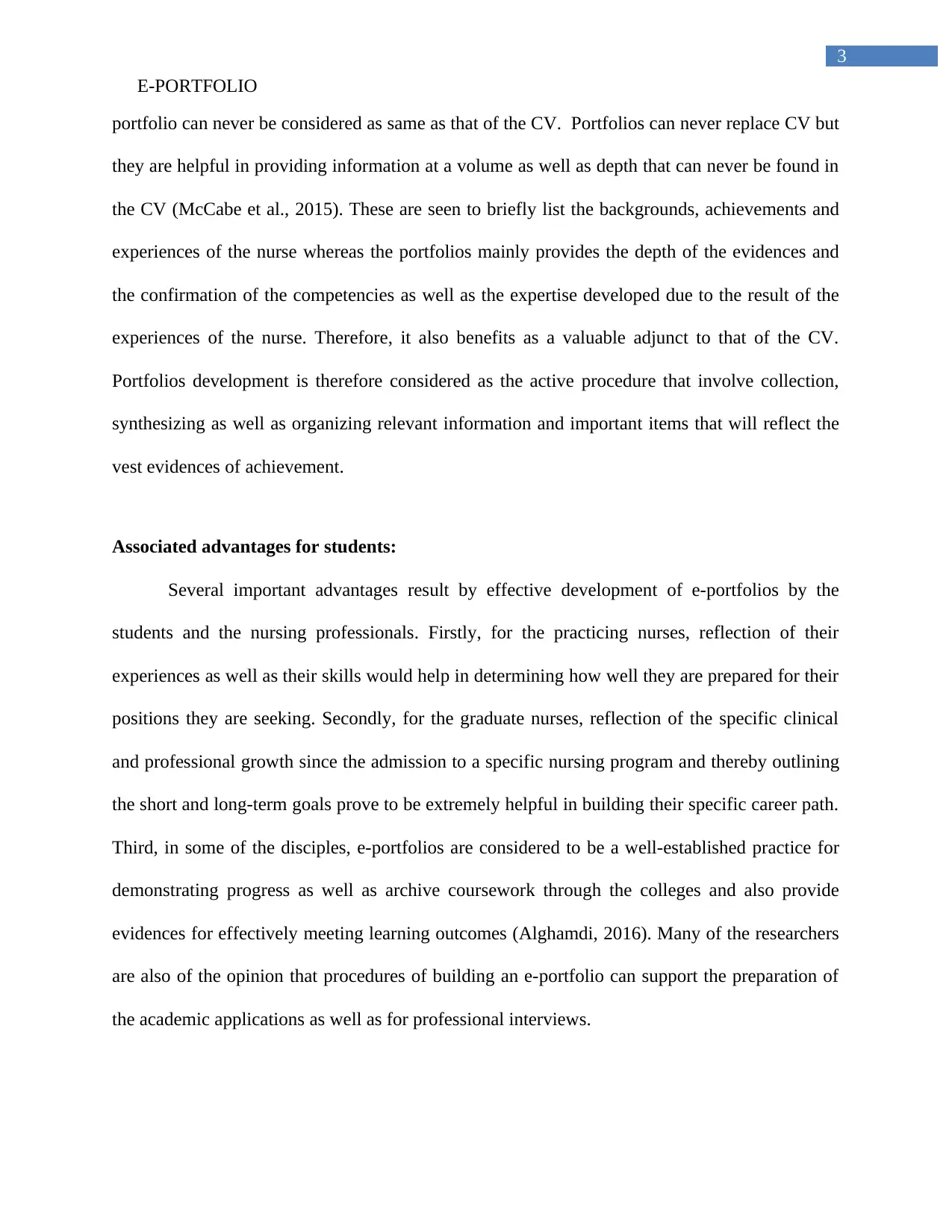
3
E-PORTFOLIO
portfolio can never be considered as same as that of the CV. Portfolios can never replace CV but
they are helpful in providing information at a volume as well as depth that can never be found in
the CV (McCabe et al., 2015). These are seen to briefly list the backgrounds, achievements and
experiences of the nurse whereas the portfolios mainly provides the depth of the evidences and
the confirmation of the competencies as well as the expertise developed due to the result of the
experiences of the nurse. Therefore, it also benefits as a valuable adjunct to that of the CV.
Portfolios development is therefore considered as the active procedure that involve collection,
synthesizing as well as organizing relevant information and important items that will reflect the
vest evidences of achievement.
Associated advantages for students:
Several important advantages result by effective development of e-portfolios by the
students and the nursing professionals. Firstly, for the practicing nurses, reflection of their
experiences as well as their skills would help in determining how well they are prepared for their
positions they are seeking. Secondly, for the graduate nurses, reflection of the specific clinical
and professional growth since the admission to a specific nursing program and thereby outlining
the short and long-term goals prove to be extremely helpful in building their specific career path.
Third, in some of the disciples, e-portfolios are considered to be a well-established practice for
demonstrating progress as well as archive coursework through the colleges and also provide
evidences for effectively meeting learning outcomes (Alghamdi, 2016). Many of the researchers
are also of the opinion that procedures of building an e-portfolio can support the preparation of
the academic applications as well as for professional interviews.
E-PORTFOLIO
portfolio can never be considered as same as that of the CV. Portfolios can never replace CV but
they are helpful in providing information at a volume as well as depth that can never be found in
the CV (McCabe et al., 2015). These are seen to briefly list the backgrounds, achievements and
experiences of the nurse whereas the portfolios mainly provides the depth of the evidences and
the confirmation of the competencies as well as the expertise developed due to the result of the
experiences of the nurse. Therefore, it also benefits as a valuable adjunct to that of the CV.
Portfolios development is therefore considered as the active procedure that involve collection,
synthesizing as well as organizing relevant information and important items that will reflect the
vest evidences of achievement.
Associated advantages for students:
Several important advantages result by effective development of e-portfolios by the
students and the nursing professionals. Firstly, for the practicing nurses, reflection of their
experiences as well as their skills would help in determining how well they are prepared for their
positions they are seeking. Secondly, for the graduate nurses, reflection of the specific clinical
and professional growth since the admission to a specific nursing program and thereby outlining
the short and long-term goals prove to be extremely helpful in building their specific career path.
Third, in some of the disciples, e-portfolios are considered to be a well-established practice for
demonstrating progress as well as archive coursework through the colleges and also provide
evidences for effectively meeting learning outcomes (Alghamdi, 2016). Many of the researchers
are also of the opinion that procedures of building an e-portfolio can support the preparation of
the academic applications as well as for professional interviews.
Secure Best Marks with AI Grader
Need help grading? Try our AI Grader for instant feedback on your assignments.
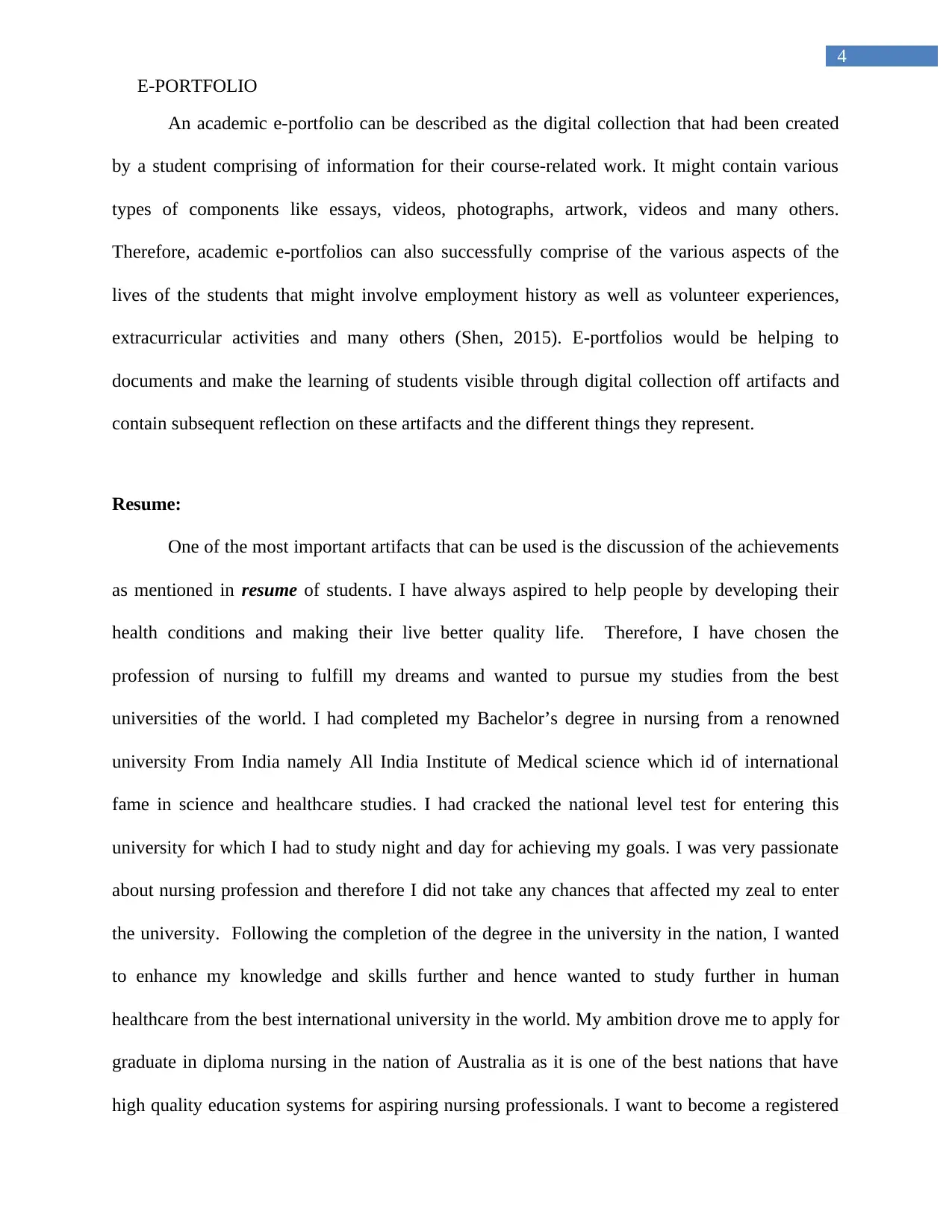
4
E-PORTFOLIO
An academic e-portfolio can be described as the digital collection that had been created
by a student comprising of information for their course-related work. It might contain various
types of components like essays, videos, photographs, artwork, videos and many others.
Therefore, academic e-portfolios can also successfully comprise of the various aspects of the
lives of the students that might involve employment history as well as volunteer experiences,
extracurricular activities and many others (Shen, 2015). E-portfolios would be helping to
documents and make the learning of students visible through digital collection off artifacts and
contain subsequent reflection on these artifacts and the different things they represent.
Resume:
One of the most important artifacts that can be used is the discussion of the achievements
as mentioned in resume of students. I have always aspired to help people by developing their
health conditions and making their live better quality life. Therefore, I have chosen the
profession of nursing to fulfill my dreams and wanted to pursue my studies from the best
universities of the world. I had completed my Bachelor’s degree in nursing from a renowned
university From India namely All India Institute of Medical science which id of international
fame in science and healthcare studies. I had cracked the national level test for entering this
university for which I had to study night and day for achieving my goals. I was very passionate
about nursing profession and therefore I did not take any chances that affected my zeal to enter
the university. Following the completion of the degree in the university in the nation, I wanted
to enhance my knowledge and skills further and hence wanted to study further in human
healthcare from the best international university in the world. My ambition drove me to apply for
graduate in diploma nursing in the nation of Australia as it is one of the best nations that have
high quality education systems for aspiring nursing professionals. I want to become a registered
E-PORTFOLIO
An academic e-portfolio can be described as the digital collection that had been created
by a student comprising of information for their course-related work. It might contain various
types of components like essays, videos, photographs, artwork, videos and many others.
Therefore, academic e-portfolios can also successfully comprise of the various aspects of the
lives of the students that might involve employment history as well as volunteer experiences,
extracurricular activities and many others (Shen, 2015). E-portfolios would be helping to
documents and make the learning of students visible through digital collection off artifacts and
contain subsequent reflection on these artifacts and the different things they represent.
Resume:
One of the most important artifacts that can be used is the discussion of the achievements
as mentioned in resume of students. I have always aspired to help people by developing their
health conditions and making their live better quality life. Therefore, I have chosen the
profession of nursing to fulfill my dreams and wanted to pursue my studies from the best
universities of the world. I had completed my Bachelor’s degree in nursing from a renowned
university From India namely All India Institute of Medical science which id of international
fame in science and healthcare studies. I had cracked the national level test for entering this
university for which I had to study night and day for achieving my goals. I was very passionate
about nursing profession and therefore I did not take any chances that affected my zeal to enter
the university. Following the completion of the degree in the university in the nation, I wanted
to enhance my knowledge and skills further and hence wanted to study further in human
healthcare from the best international university in the world. My ambition drove me to apply for
graduate in diploma nursing in the nation of Australia as it is one of the best nations that have
high quality education systems for aspiring nursing professionals. I want to become a registered
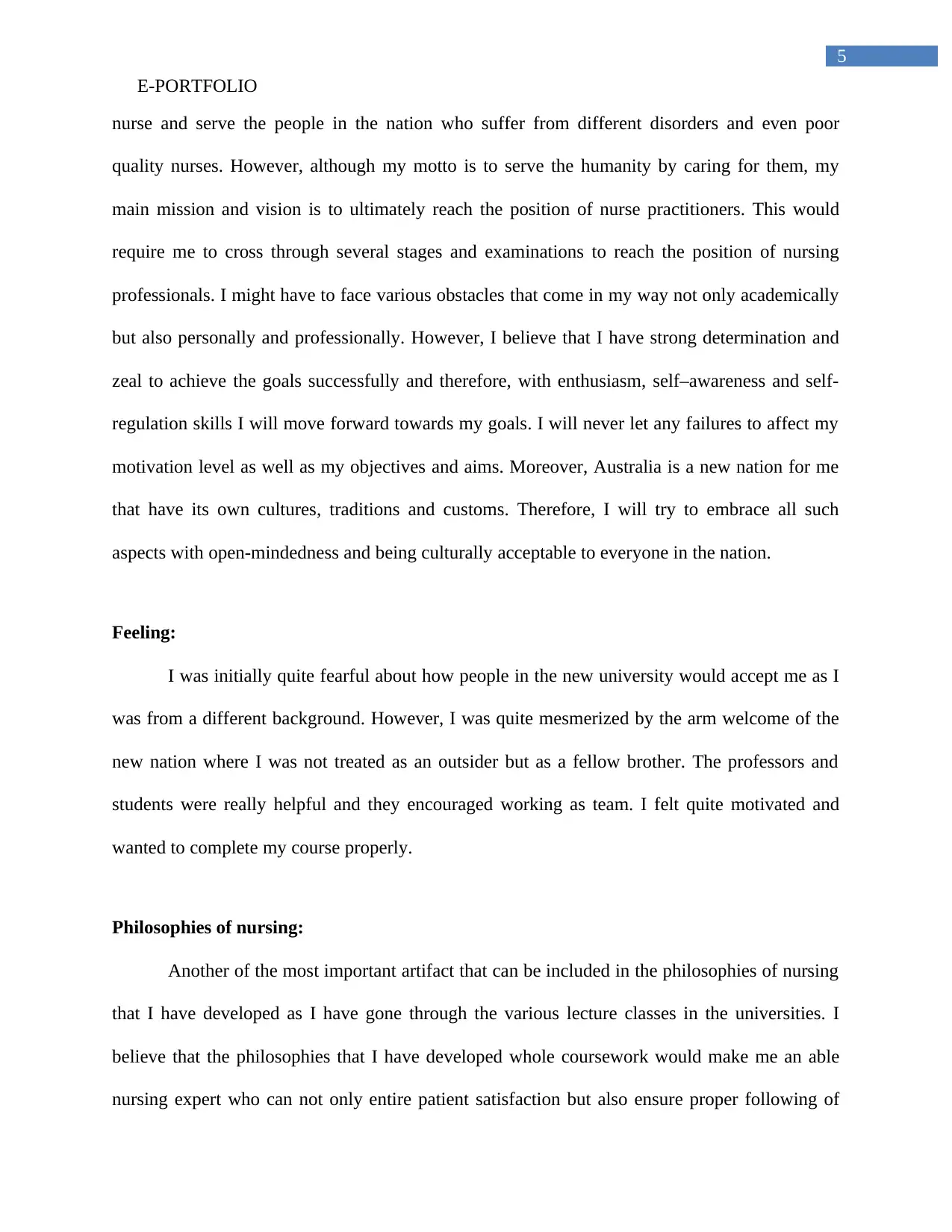
5
E-PORTFOLIO
nurse and serve the people in the nation who suffer from different disorders and even poor
quality nurses. However, although my motto is to serve the humanity by caring for them, my
main mission and vision is to ultimately reach the position of nurse practitioners. This would
require me to cross through several stages and examinations to reach the position of nursing
professionals. I might have to face various obstacles that come in my way not only academically
but also personally and professionally. However, I believe that I have strong determination and
zeal to achieve the goals successfully and therefore, with enthusiasm, self–awareness and self-
regulation skills I will move forward towards my goals. I will never let any failures to affect my
motivation level as well as my objectives and aims. Moreover, Australia is a new nation for me
that have its own cultures, traditions and customs. Therefore, I will try to embrace all such
aspects with open-mindedness and being culturally acceptable to everyone in the nation.
Feeling:
I was initially quite fearful about how people in the new university would accept me as I
was from a different background. However, I was quite mesmerized by the arm welcome of the
new nation where I was not treated as an outsider but as a fellow brother. The professors and
students were really helpful and they encouraged working as team. I felt quite motivated and
wanted to complete my course properly.
Philosophies of nursing:
Another of the most important artifact that can be included in the philosophies of nursing
that I have developed as I have gone through the various lecture classes in the universities. I
believe that the philosophies that I have developed whole coursework would make me an able
nursing expert who can not only entire patient satisfaction but also ensure proper following of
E-PORTFOLIO
nurse and serve the people in the nation who suffer from different disorders and even poor
quality nurses. However, although my motto is to serve the humanity by caring for them, my
main mission and vision is to ultimately reach the position of nurse practitioners. This would
require me to cross through several stages and examinations to reach the position of nursing
professionals. I might have to face various obstacles that come in my way not only academically
but also personally and professionally. However, I believe that I have strong determination and
zeal to achieve the goals successfully and therefore, with enthusiasm, self–awareness and self-
regulation skills I will move forward towards my goals. I will never let any failures to affect my
motivation level as well as my objectives and aims. Moreover, Australia is a new nation for me
that have its own cultures, traditions and customs. Therefore, I will try to embrace all such
aspects with open-mindedness and being culturally acceptable to everyone in the nation.
Feeling:
I was initially quite fearful about how people in the new university would accept me as I
was from a different background. However, I was quite mesmerized by the arm welcome of the
new nation where I was not treated as an outsider but as a fellow brother. The professors and
students were really helpful and they encouraged working as team. I felt quite motivated and
wanted to complete my course properly.
Philosophies of nursing:
Another of the most important artifact that can be included in the philosophies of nursing
that I have developed as I have gone through the various lecture classes in the universities. I
believe that the philosophies that I have developed whole coursework would make me an able
nursing expert who can not only entire patient satisfaction but also ensure proper following of
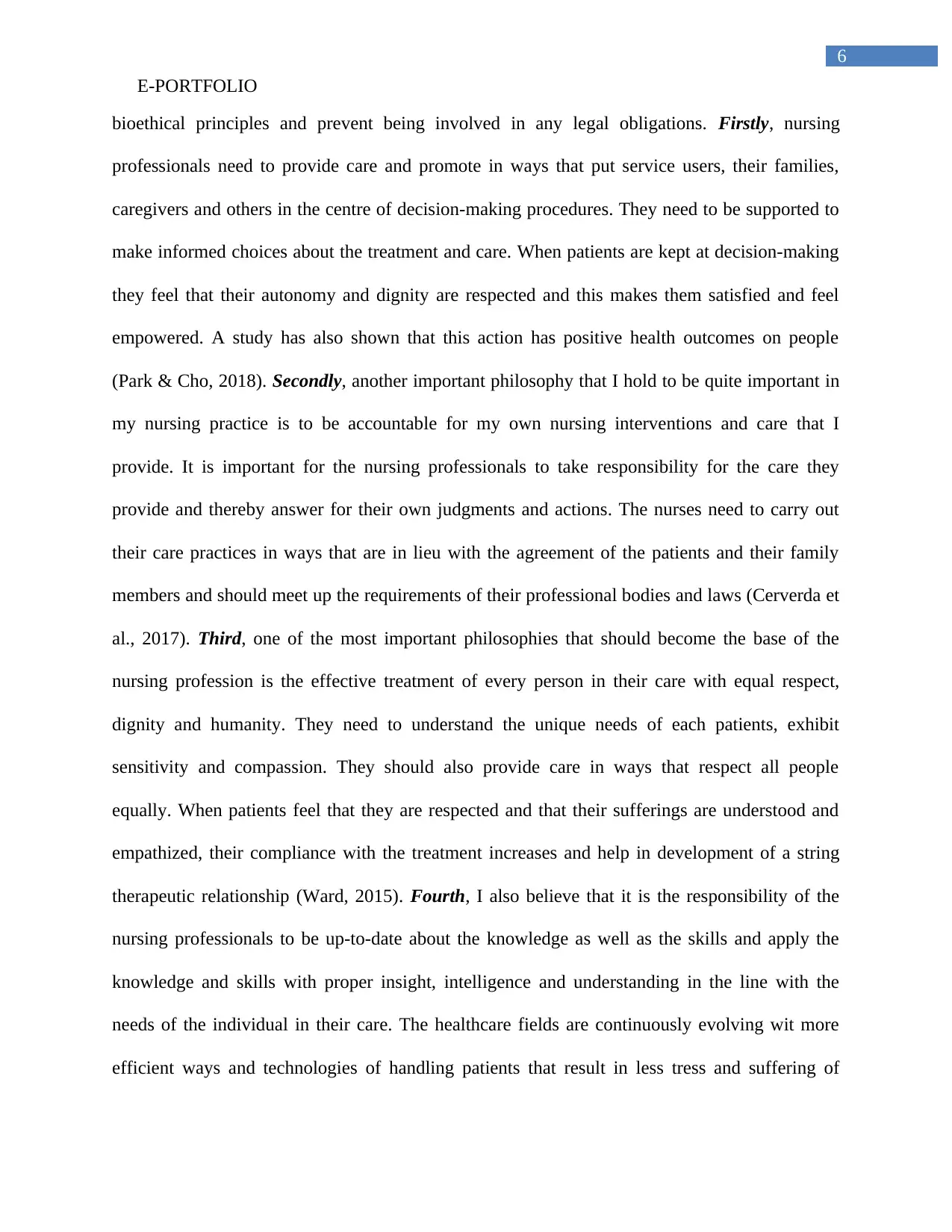
6
E-PORTFOLIO
bioethical principles and prevent being involved in any legal obligations. Firstly, nursing
professionals need to provide care and promote in ways that put service users, their families,
caregivers and others in the centre of decision-making procedures. They need to be supported to
make informed choices about the treatment and care. When patients are kept at decision-making
they feel that their autonomy and dignity are respected and this makes them satisfied and feel
empowered. A study has also shown that this action has positive health outcomes on people
(Park & Cho, 2018). Secondly, another important philosophy that I hold to be quite important in
my nursing practice is to be accountable for my own nursing interventions and care that I
provide. It is important for the nursing professionals to take responsibility for the care they
provide and thereby answer for their own judgments and actions. The nurses need to carry out
their care practices in ways that are in lieu with the agreement of the patients and their family
members and should meet up the requirements of their professional bodies and laws (Cerverda et
al., 2017). Third, one of the most important philosophies that should become the base of the
nursing profession is the effective treatment of every person in their care with equal respect,
dignity and humanity. They need to understand the unique needs of each patients, exhibit
sensitivity and compassion. They should also provide care in ways that respect all people
equally. When patients feel that they are respected and that their sufferings are understood and
empathized, their compliance with the treatment increases and help in development of a string
therapeutic relationship (Ward, 2015). Fourth, I also believe that it is the responsibility of the
nursing professionals to be up-to-date about the knowledge as well as the skills and apply the
knowledge and skills with proper insight, intelligence and understanding in the line with the
needs of the individual in their care. The healthcare fields are continuously evolving wit more
efficient ways and technologies of handling patients that result in less tress and suffering of
E-PORTFOLIO
bioethical principles and prevent being involved in any legal obligations. Firstly, nursing
professionals need to provide care and promote in ways that put service users, their families,
caregivers and others in the centre of decision-making procedures. They need to be supported to
make informed choices about the treatment and care. When patients are kept at decision-making
they feel that their autonomy and dignity are respected and this makes them satisfied and feel
empowered. A study has also shown that this action has positive health outcomes on people
(Park & Cho, 2018). Secondly, another important philosophy that I hold to be quite important in
my nursing practice is to be accountable for my own nursing interventions and care that I
provide. It is important for the nursing professionals to take responsibility for the care they
provide and thereby answer for their own judgments and actions. The nurses need to carry out
their care practices in ways that are in lieu with the agreement of the patients and their family
members and should meet up the requirements of their professional bodies and laws (Cerverda et
al., 2017). Third, one of the most important philosophies that should become the base of the
nursing profession is the effective treatment of every person in their care with equal respect,
dignity and humanity. They need to understand the unique needs of each patients, exhibit
sensitivity and compassion. They should also provide care in ways that respect all people
equally. When patients feel that they are respected and that their sufferings are understood and
empathized, their compliance with the treatment increases and help in development of a string
therapeutic relationship (Ward, 2015). Fourth, I also believe that it is the responsibility of the
nursing professionals to be up-to-date about the knowledge as well as the skills and apply the
knowledge and skills with proper insight, intelligence and understanding in the line with the
needs of the individual in their care. The healthcare fields are continuously evolving wit more
efficient ways and technologies of handling patients that result in less tress and suffering of
Paraphrase This Document
Need a fresh take? Get an instant paraphrase of this document with our AI Paraphraser
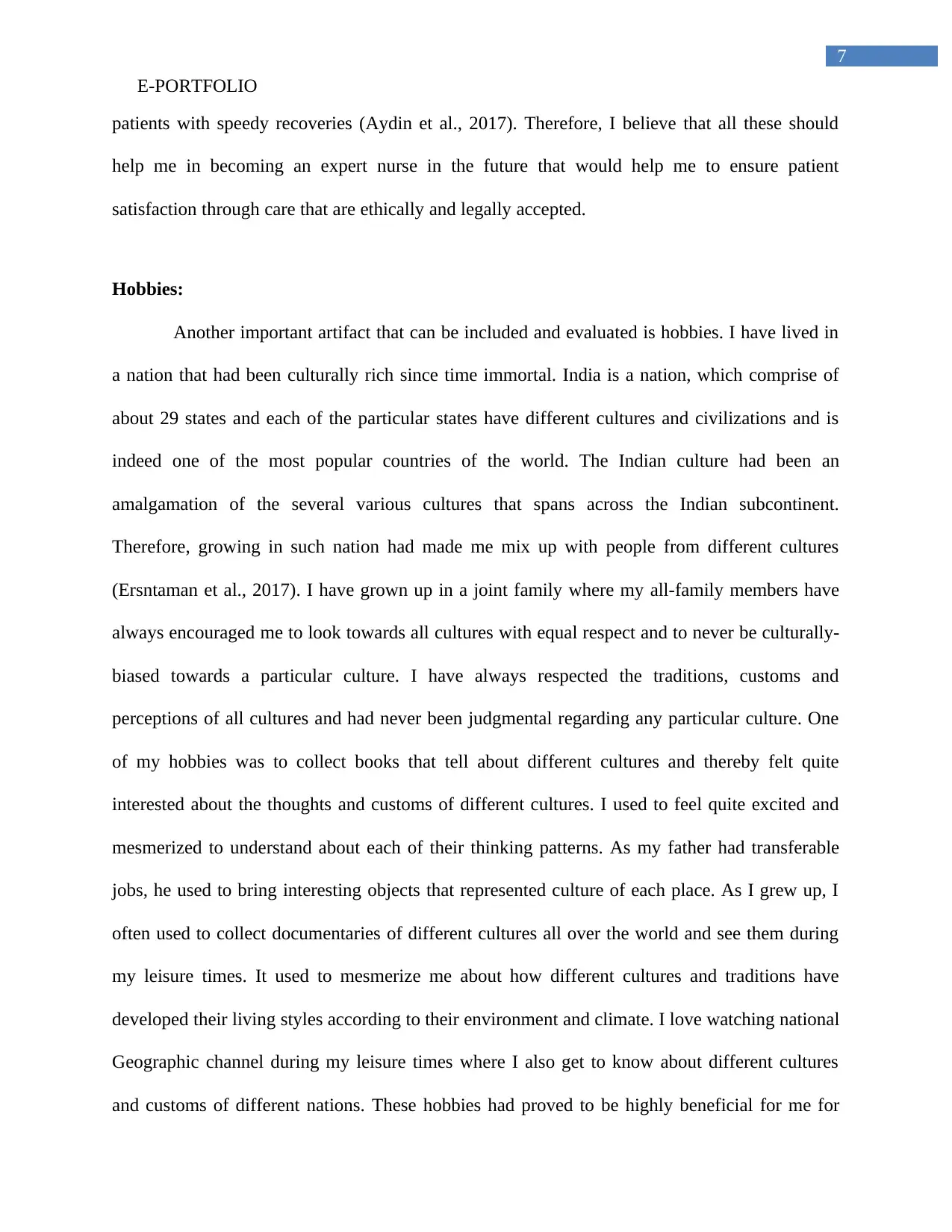
7
E-PORTFOLIO
patients with speedy recoveries (Aydin et al., 2017). Therefore, I believe that all these should
help me in becoming an expert nurse in the future that would help me to ensure patient
satisfaction through care that are ethically and legally accepted.
Hobbies:
Another important artifact that can be included and evaluated is hobbies. I have lived in
a nation that had been culturally rich since time immortal. India is a nation, which comprise of
about 29 states and each of the particular states have different cultures and civilizations and is
indeed one of the most popular countries of the world. The Indian culture had been an
amalgamation of the several various cultures that spans across the Indian subcontinent.
Therefore, growing in such nation had made me mix up with people from different cultures
(Ersntaman et al., 2017). I have grown up in a joint family where my all-family members have
always encouraged me to look towards all cultures with equal respect and to never be culturally-
biased towards a particular culture. I have always respected the traditions, customs and
perceptions of all cultures and had never been judgmental regarding any particular culture. One
of my hobbies was to collect books that tell about different cultures and thereby felt quite
interested about the thoughts and customs of different cultures. I used to feel quite excited and
mesmerized to understand about each of their thinking patterns. As my father had transferable
jobs, he used to bring interesting objects that represented culture of each place. As I grew up, I
often used to collect documentaries of different cultures all over the world and see them during
my leisure times. It used to mesmerize me about how different cultures and traditions have
developed their living styles according to their environment and climate. I love watching national
Geographic channel during my leisure times where I also get to know about different cultures
and customs of different nations. These hobbies had proved to be highly beneficial for me for
E-PORTFOLIO
patients with speedy recoveries (Aydin et al., 2017). Therefore, I believe that all these should
help me in becoming an expert nurse in the future that would help me to ensure patient
satisfaction through care that are ethically and legally accepted.
Hobbies:
Another important artifact that can be included and evaluated is hobbies. I have lived in
a nation that had been culturally rich since time immortal. India is a nation, which comprise of
about 29 states and each of the particular states have different cultures and civilizations and is
indeed one of the most popular countries of the world. The Indian culture had been an
amalgamation of the several various cultures that spans across the Indian subcontinent.
Therefore, growing in such nation had made me mix up with people from different cultures
(Ersntaman et al., 2017). I have grown up in a joint family where my all-family members have
always encouraged me to look towards all cultures with equal respect and to never be culturally-
biased towards a particular culture. I have always respected the traditions, customs and
perceptions of all cultures and had never been judgmental regarding any particular culture. One
of my hobbies was to collect books that tell about different cultures and thereby felt quite
interested about the thoughts and customs of different cultures. I used to feel quite excited and
mesmerized to understand about each of their thinking patterns. As my father had transferable
jobs, he used to bring interesting objects that represented culture of each place. As I grew up, I
often used to collect documentaries of different cultures all over the world and see them during
my leisure times. It used to mesmerize me about how different cultures and traditions have
developed their living styles according to their environment and climate. I love watching national
Geographic channel during my leisure times where I also get to know about different cultures
and customs of different nations. These hobbies had proved to be highly beneficial for me for
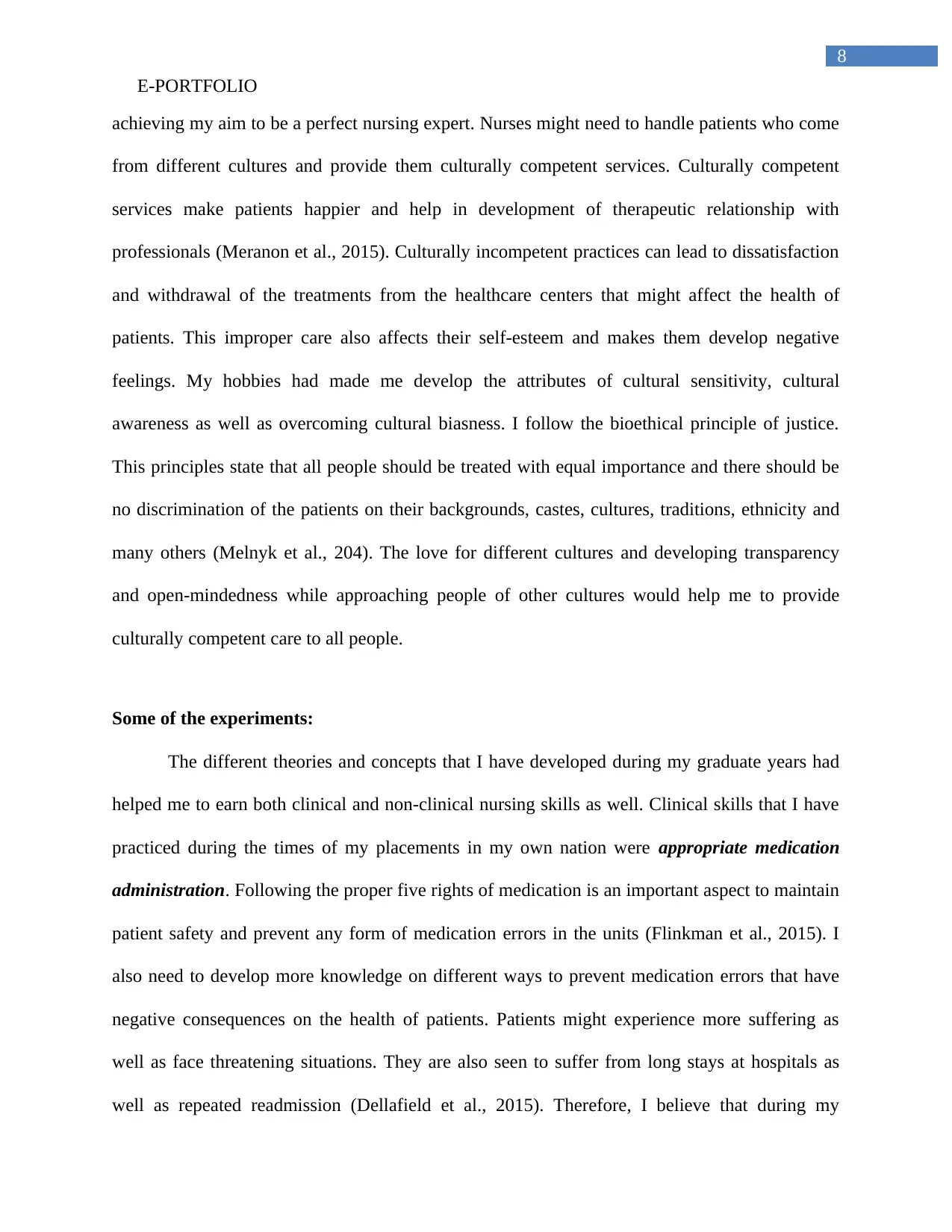
8
E-PORTFOLIO
achieving my aim to be a perfect nursing expert. Nurses might need to handle patients who come
from different cultures and provide them culturally competent services. Culturally competent
services make patients happier and help in development of therapeutic relationship with
professionals (Meranon et al., 2015). Culturally incompetent practices can lead to dissatisfaction
and withdrawal of the treatments from the healthcare centers that might affect the health of
patients. This improper care also affects their self-esteem and makes them develop negative
feelings. My hobbies had made me develop the attributes of cultural sensitivity, cultural
awareness as well as overcoming cultural biasness. I follow the bioethical principle of justice.
This principles state that all people should be treated with equal importance and there should be
no discrimination of the patients on their backgrounds, castes, cultures, traditions, ethnicity and
many others (Melnyk et al., 204). The love for different cultures and developing transparency
and open-mindedness while approaching people of other cultures would help me to provide
culturally competent care to all people.
Some of the experiments:
The different theories and concepts that I have developed during my graduate years had
helped me to earn both clinical and non-clinical nursing skills as well. Clinical skills that I have
practiced during the times of my placements in my own nation were appropriate medication
administration. Following the proper five rights of medication is an important aspect to maintain
patient safety and prevent any form of medication errors in the units (Flinkman et al., 2015). I
also need to develop more knowledge on different ways to prevent medication errors that have
negative consequences on the health of patients. Patients might experience more suffering as
well as face threatening situations. They are also seen to suffer from long stays at hospitals as
well as repeated readmission (Dellafield et al., 2015). Therefore, I believe that during my
E-PORTFOLIO
achieving my aim to be a perfect nursing expert. Nurses might need to handle patients who come
from different cultures and provide them culturally competent services. Culturally competent
services make patients happier and help in development of therapeutic relationship with
professionals (Meranon et al., 2015). Culturally incompetent practices can lead to dissatisfaction
and withdrawal of the treatments from the healthcare centers that might affect the health of
patients. This improper care also affects their self-esteem and makes them develop negative
feelings. My hobbies had made me develop the attributes of cultural sensitivity, cultural
awareness as well as overcoming cultural biasness. I follow the bioethical principle of justice.
This principles state that all people should be treated with equal importance and there should be
no discrimination of the patients on their backgrounds, castes, cultures, traditions, ethnicity and
many others (Melnyk et al., 204). The love for different cultures and developing transparency
and open-mindedness while approaching people of other cultures would help me to provide
culturally competent care to all people.
Some of the experiments:
The different theories and concepts that I have developed during my graduate years had
helped me to earn both clinical and non-clinical nursing skills as well. Clinical skills that I have
practiced during the times of my placements in my own nation were appropriate medication
administration. Following the proper five rights of medication is an important aspect to maintain
patient safety and prevent any form of medication errors in the units (Flinkman et al., 2015). I
also need to develop more knowledge on different ways to prevent medication errors that have
negative consequences on the health of patients. Patients might experience more suffering as
well as face threatening situations. They are also seen to suffer from long stays at hospitals as
well as repeated readmission (Dellafield et al., 2015). Therefore, I believe that during my
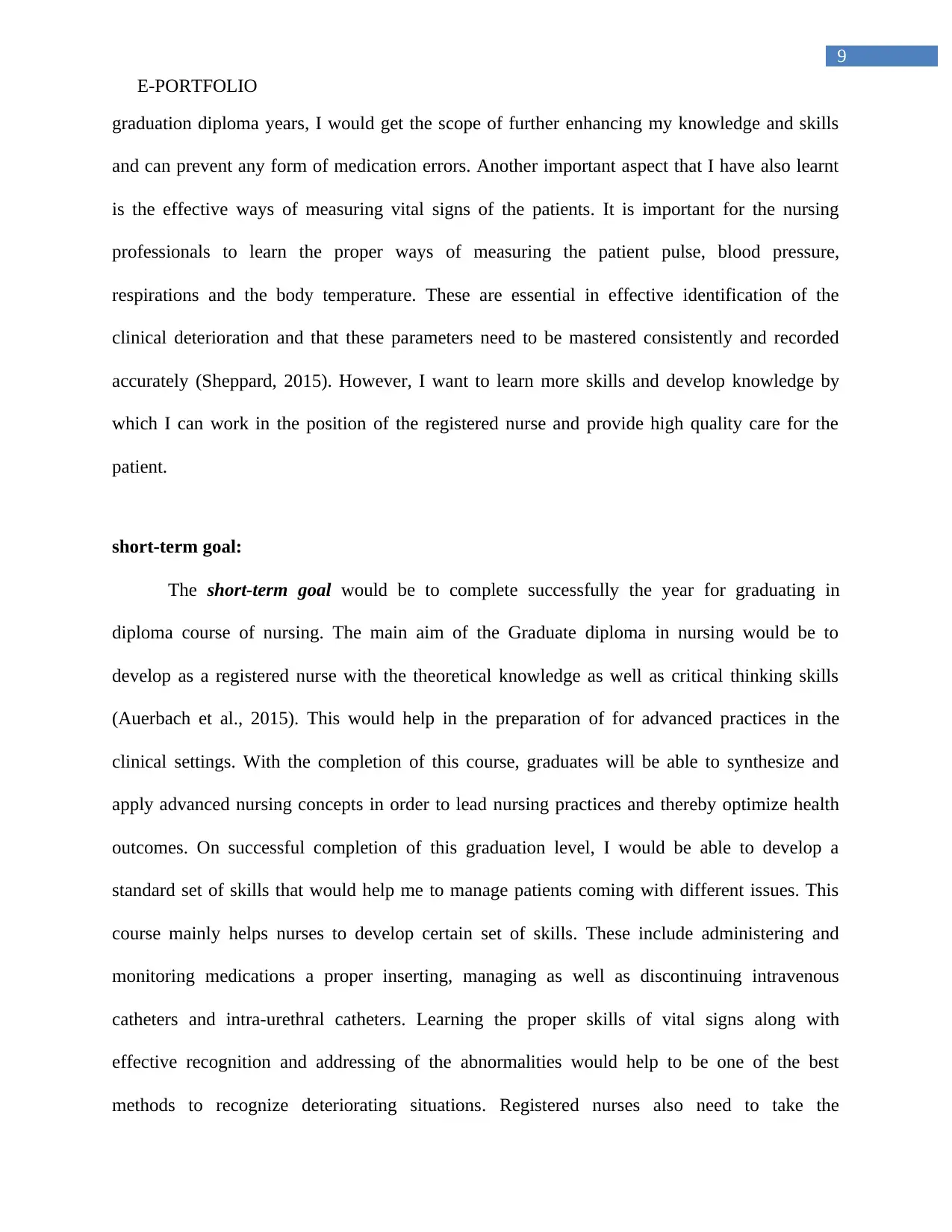
9
E-PORTFOLIO
graduation diploma years, I would get the scope of further enhancing my knowledge and skills
and can prevent any form of medication errors. Another important aspect that I have also learnt
is the effective ways of measuring vital signs of the patients. It is important for the nursing
professionals to learn the proper ways of measuring the patient pulse, blood pressure,
respirations and the body temperature. These are essential in effective identification of the
clinical deterioration and that these parameters need to be mastered consistently and recorded
accurately (Sheppard, 2015). However, I want to learn more skills and develop knowledge by
which I can work in the position of the registered nurse and provide high quality care for the
patient.
short-term goal:
The short-term goal would be to complete successfully the year for graduating in
diploma course of nursing. The main aim of the Graduate diploma in nursing would be to
develop as a registered nurse with the theoretical knowledge as well as critical thinking skills
(Auerbach et al., 2015). This would help in the preparation of for advanced practices in the
clinical settings. With the completion of this course, graduates will be able to synthesize and
apply advanced nursing concepts in order to lead nursing practices and thereby optimize health
outcomes. On successful completion of this graduation level, I would be able to develop a
standard set of skills that would help me to manage patients coming with different issues. This
course mainly helps nurses to develop certain set of skills. These include administering and
monitoring medications a proper inserting, managing as well as discontinuing intravenous
catheters and intra-urethral catheters. Learning the proper skills of vital signs along with
effective recognition and addressing of the abnormalities would help to be one of the best
methods to recognize deteriorating situations. Registered nurses also need to take the
E-PORTFOLIO
graduation diploma years, I would get the scope of further enhancing my knowledge and skills
and can prevent any form of medication errors. Another important aspect that I have also learnt
is the effective ways of measuring vital signs of the patients. It is important for the nursing
professionals to learn the proper ways of measuring the patient pulse, blood pressure,
respirations and the body temperature. These are essential in effective identification of the
clinical deterioration and that these parameters need to be mastered consistently and recorded
accurately (Sheppard, 2015). However, I want to learn more skills and develop knowledge by
which I can work in the position of the registered nurse and provide high quality care for the
patient.
short-term goal:
The short-term goal would be to complete successfully the year for graduating in
diploma course of nursing. The main aim of the Graduate diploma in nursing would be to
develop as a registered nurse with the theoretical knowledge as well as critical thinking skills
(Auerbach et al., 2015). This would help in the preparation of for advanced practices in the
clinical settings. With the completion of this course, graduates will be able to synthesize and
apply advanced nursing concepts in order to lead nursing practices and thereby optimize health
outcomes. On successful completion of this graduation level, I would be able to develop a
standard set of skills that would help me to manage patients coming with different issues. This
course mainly helps nurses to develop certain set of skills. These include administering and
monitoring medications a proper inserting, managing as well as discontinuing intravenous
catheters and intra-urethral catheters. Learning the proper skills of vital signs along with
effective recognition and addressing of the abnormalities would help to be one of the best
methods to recognize deteriorating situations. Registered nurses also need to take the
Secure Best Marks with AI Grader
Need help grading? Try our AI Grader for instant feedback on your assignments.
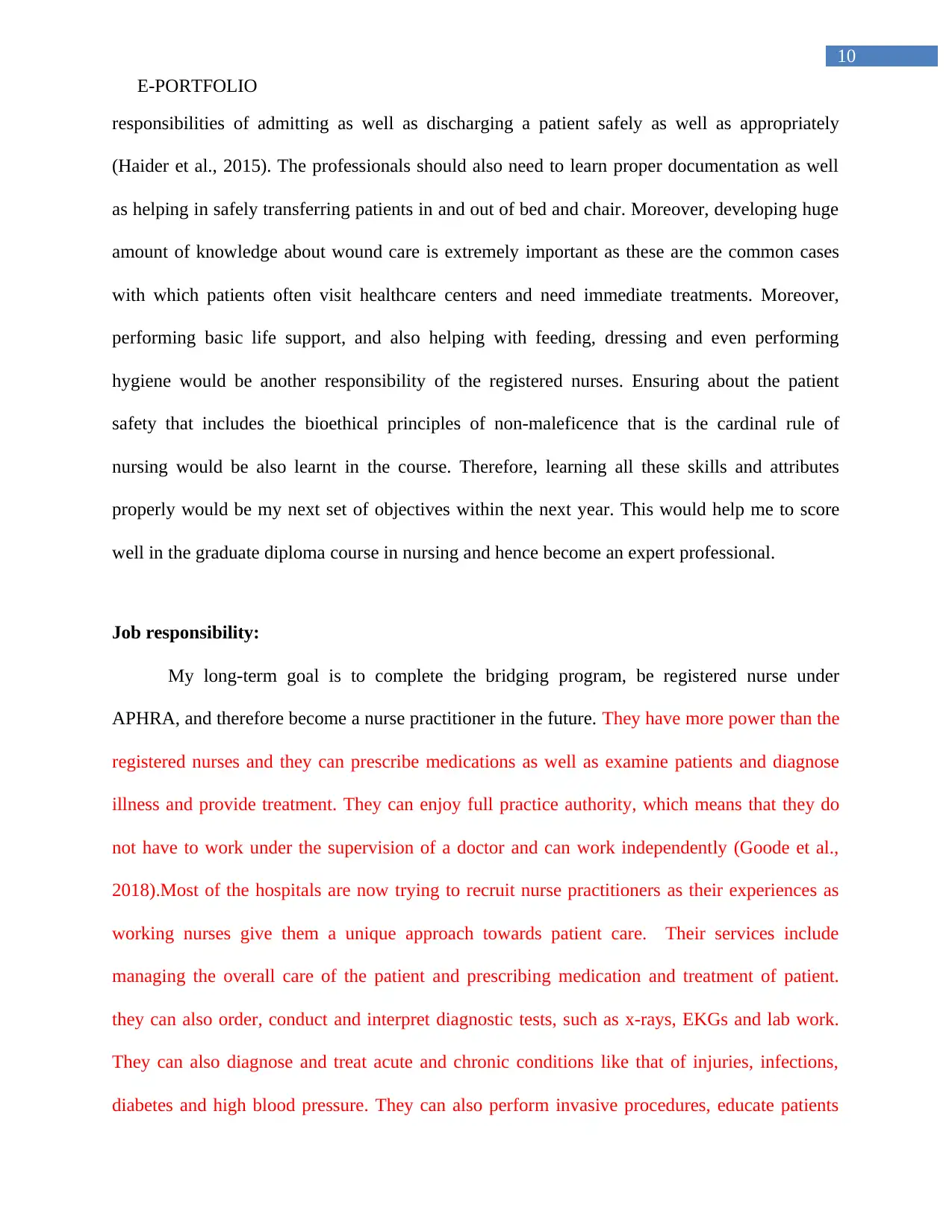
10
E-PORTFOLIO
responsibilities of admitting as well as discharging a patient safely as well as appropriately
(Haider et al., 2015). The professionals should also need to learn proper documentation as well
as helping in safely transferring patients in and out of bed and chair. Moreover, developing huge
amount of knowledge about wound care is extremely important as these are the common cases
with which patients often visit healthcare centers and need immediate treatments. Moreover,
performing basic life support, and also helping with feeding, dressing and even performing
hygiene would be another responsibility of the registered nurses. Ensuring about the patient
safety that includes the bioethical principles of non-maleficence that is the cardinal rule of
nursing would be also learnt in the course. Therefore, learning all these skills and attributes
properly would be my next set of objectives within the next year. This would help me to score
well in the graduate diploma course in nursing and hence become an expert professional.
Job responsibility:
My long-term goal is to complete the bridging program, be registered nurse under
APHRA, and therefore become a nurse practitioner in the future. They have more power than the
registered nurses and they can prescribe medications as well as examine patients and diagnose
illness and provide treatment. They can enjoy full practice authority, which means that they do
not have to work under the supervision of a doctor and can work independently (Goode et al.,
2018).Most of the hospitals are now trying to recruit nurse practitioners as their experiences as
working nurses give them a unique approach towards patient care. Their services include
managing the overall care of the patient and prescribing medication and treatment of patient.
they can also order, conduct and interpret diagnostic tests, such as x-rays, EKGs and lab work.
They can also diagnose and treat acute and chronic conditions like that of injuries, infections,
diabetes and high blood pressure. They can also perform invasive procedures, educate patients
E-PORTFOLIO
responsibilities of admitting as well as discharging a patient safely as well as appropriately
(Haider et al., 2015). The professionals should also need to learn proper documentation as well
as helping in safely transferring patients in and out of bed and chair. Moreover, developing huge
amount of knowledge about wound care is extremely important as these are the common cases
with which patients often visit healthcare centers and need immediate treatments. Moreover,
performing basic life support, and also helping with feeding, dressing and even performing
hygiene would be another responsibility of the registered nurses. Ensuring about the patient
safety that includes the bioethical principles of non-maleficence that is the cardinal rule of
nursing would be also learnt in the course. Therefore, learning all these skills and attributes
properly would be my next set of objectives within the next year. This would help me to score
well in the graduate diploma course in nursing and hence become an expert professional.
Job responsibility:
My long-term goal is to complete the bridging program, be registered nurse under
APHRA, and therefore become a nurse practitioner in the future. They have more power than the
registered nurses and they can prescribe medications as well as examine patients and diagnose
illness and provide treatment. They can enjoy full practice authority, which means that they do
not have to work under the supervision of a doctor and can work independently (Goode et al.,
2018).Most of the hospitals are now trying to recruit nurse practitioners as their experiences as
working nurses give them a unique approach towards patient care. Their services include
managing the overall care of the patient and prescribing medication and treatment of patient.
they can also order, conduct and interpret diagnostic tests, such as x-rays, EKGs and lab work.
They can also diagnose and treat acute and chronic conditions like that of injuries, infections,
diabetes and high blood pressure. They can also perform invasive procedures, educate patients
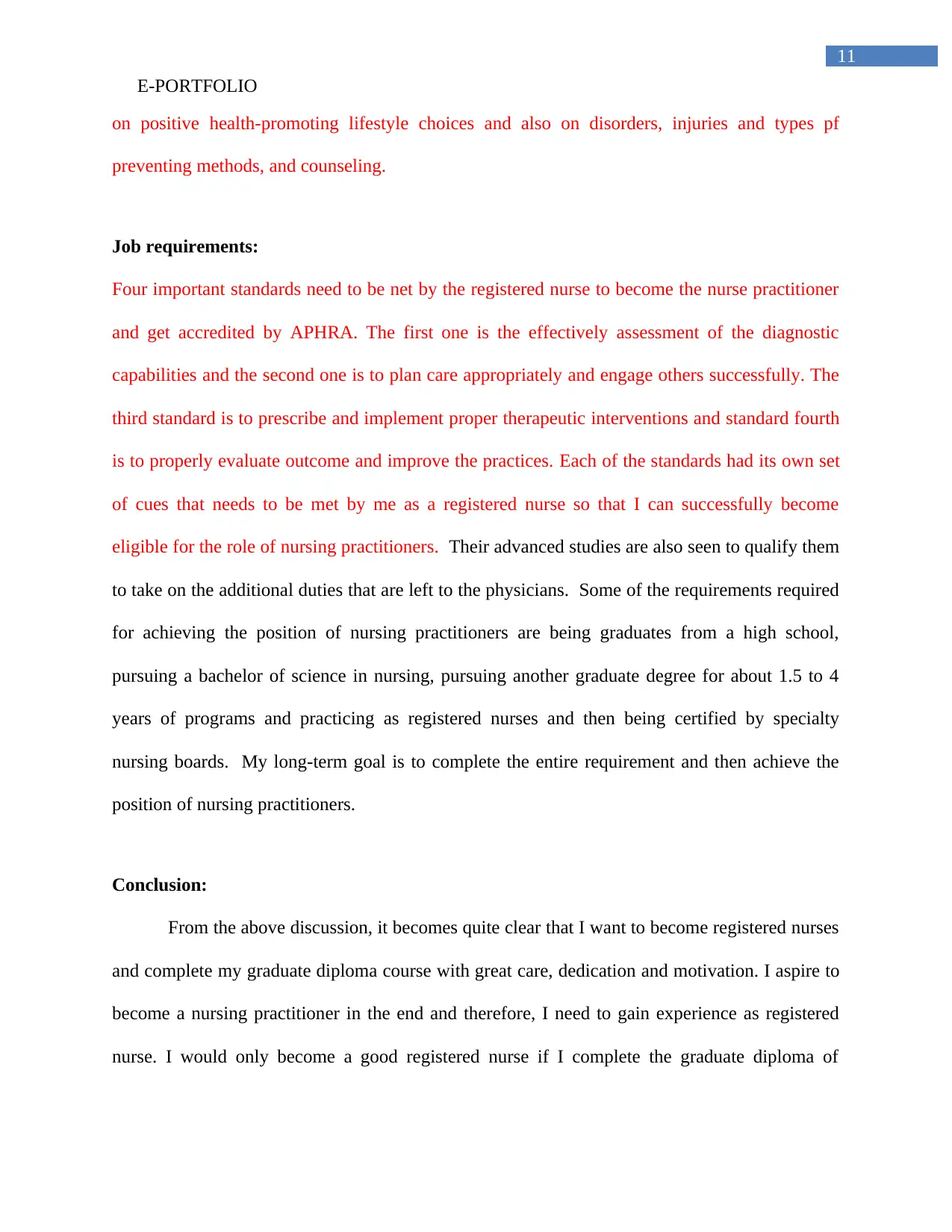
11
E-PORTFOLIO
on positive health-promoting lifestyle choices and also on disorders, injuries and types pf
preventing methods, and counseling.
Job requirements:
Four important standards need to be net by the registered nurse to become the nurse practitioner
and get accredited by APHRA. The first one is the effectively assessment of the diagnostic
capabilities and the second one is to plan care appropriately and engage others successfully. The
third standard is to prescribe and implement proper therapeutic interventions and standard fourth
is to properly evaluate outcome and improve the practices. Each of the standards had its own set
of cues that needs to be met by me as a registered nurse so that I can successfully become
eligible for the role of nursing practitioners. Their advanced studies are also seen to qualify them
to take on the additional duties that are left to the physicians. Some of the requirements required
for achieving the position of nursing practitioners are being graduates from a high school,
pursuing a bachelor of science in nursing, pursuing another graduate degree for about 1.5 to 4
years of programs and practicing as registered nurses and then being certified by specialty
nursing boards. My long-term goal is to complete the entire requirement and then achieve the
position of nursing practitioners.
Conclusion:
From the above discussion, it becomes quite clear that I want to become registered nurses
and complete my graduate diploma course with great care, dedication and motivation. I aspire to
become a nursing practitioner in the end and therefore, I need to gain experience as registered
nurse. I would only become a good registered nurse if I complete the graduate diploma of
E-PORTFOLIO
on positive health-promoting lifestyle choices and also on disorders, injuries and types pf
preventing methods, and counseling.
Job requirements:
Four important standards need to be net by the registered nurse to become the nurse practitioner
and get accredited by APHRA. The first one is the effectively assessment of the diagnostic
capabilities and the second one is to plan care appropriately and engage others successfully. The
third standard is to prescribe and implement proper therapeutic interventions and standard fourth
is to properly evaluate outcome and improve the practices. Each of the standards had its own set
of cues that needs to be met by me as a registered nurse so that I can successfully become
eligible for the role of nursing practitioners. Their advanced studies are also seen to qualify them
to take on the additional duties that are left to the physicians. Some of the requirements required
for achieving the position of nursing practitioners are being graduates from a high school,
pursuing a bachelor of science in nursing, pursuing another graduate degree for about 1.5 to 4
years of programs and practicing as registered nurses and then being certified by specialty
nursing boards. My long-term goal is to complete the entire requirement and then achieve the
position of nursing practitioners.
Conclusion:
From the above discussion, it becomes quite clear that I want to become registered nurses
and complete my graduate diploma course with great care, dedication and motivation. I aspire to
become a nursing practitioner in the end and therefore, I need to gain experience as registered
nurse. I would only become a good registered nurse if I complete the graduate diploma of
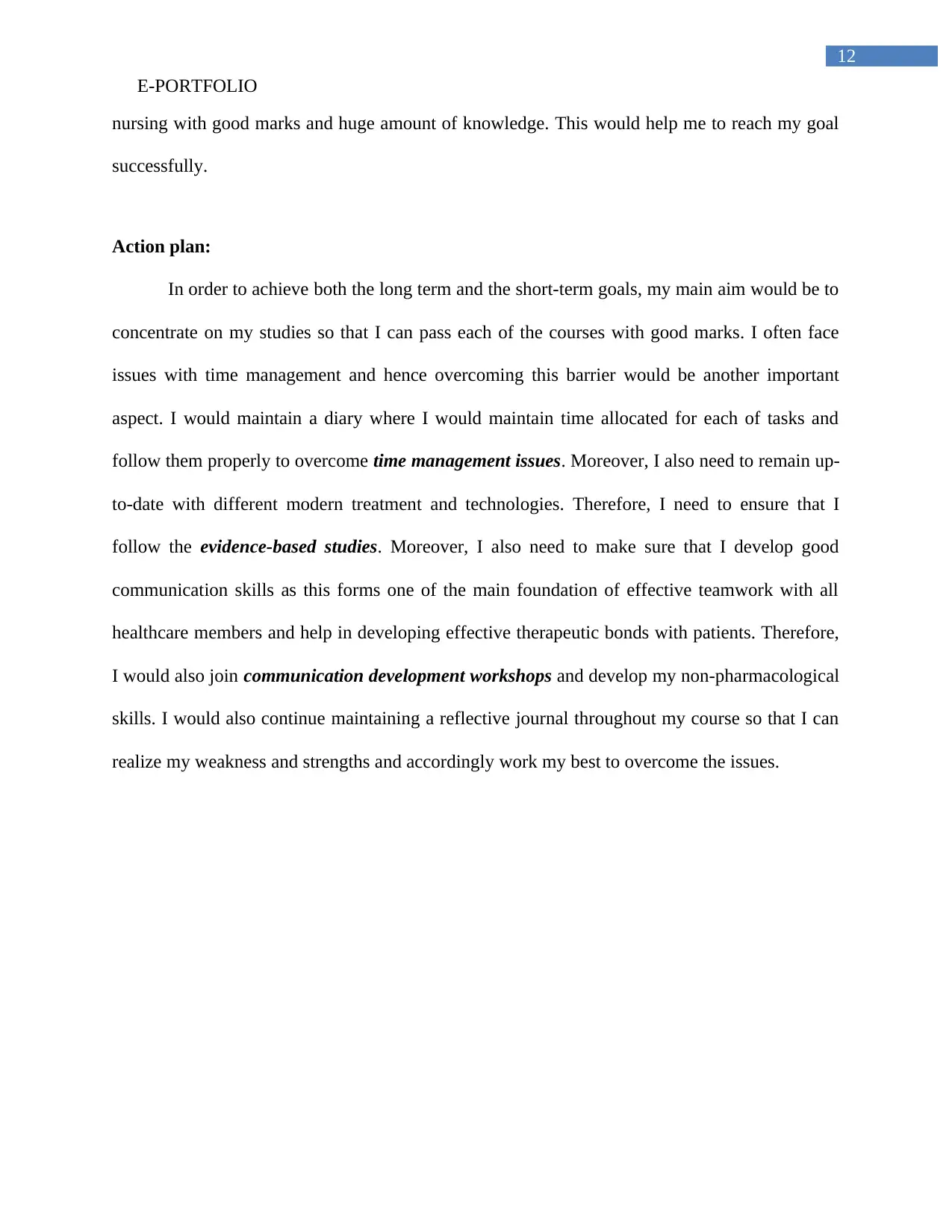
12
E-PORTFOLIO
nursing with good marks and huge amount of knowledge. This would help me to reach my goal
successfully.
Action plan:
In order to achieve both the long term and the short-term goals, my main aim would be to
concentrate on my studies so that I can pass each of the courses with good marks. I often face
issues with time management and hence overcoming this barrier would be another important
aspect. I would maintain a diary where I would maintain time allocated for each of tasks and
follow them properly to overcome time management issues. Moreover, I also need to remain up-
to-date with different modern treatment and technologies. Therefore, I need to ensure that I
follow the evidence-based studies. Moreover, I also need to make sure that I develop good
communication skills as this forms one of the main foundation of effective teamwork with all
healthcare members and help in developing effective therapeutic bonds with patients. Therefore,
I would also join communication development workshops and develop my non-pharmacological
skills. I would also continue maintaining a reflective journal throughout my course so that I can
realize my weakness and strengths and accordingly work my best to overcome the issues.
E-PORTFOLIO
nursing with good marks and huge amount of knowledge. This would help me to reach my goal
successfully.
Action plan:
In order to achieve both the long term and the short-term goals, my main aim would be to
concentrate on my studies so that I can pass each of the courses with good marks. I often face
issues with time management and hence overcoming this barrier would be another important
aspect. I would maintain a diary where I would maintain time allocated for each of tasks and
follow them properly to overcome time management issues. Moreover, I also need to remain up-
to-date with different modern treatment and technologies. Therefore, I need to ensure that I
follow the evidence-based studies. Moreover, I also need to make sure that I develop good
communication skills as this forms one of the main foundation of effective teamwork with all
healthcare members and help in developing effective therapeutic bonds with patients. Therefore,
I would also join communication development workshops and develop my non-pharmacological
skills. I would also continue maintaining a reflective journal throughout my course so that I can
realize my weakness and strengths and accordingly work my best to overcome the issues.
Paraphrase This Document
Need a fresh take? Get an instant paraphrase of this document with our AI Paraphraser
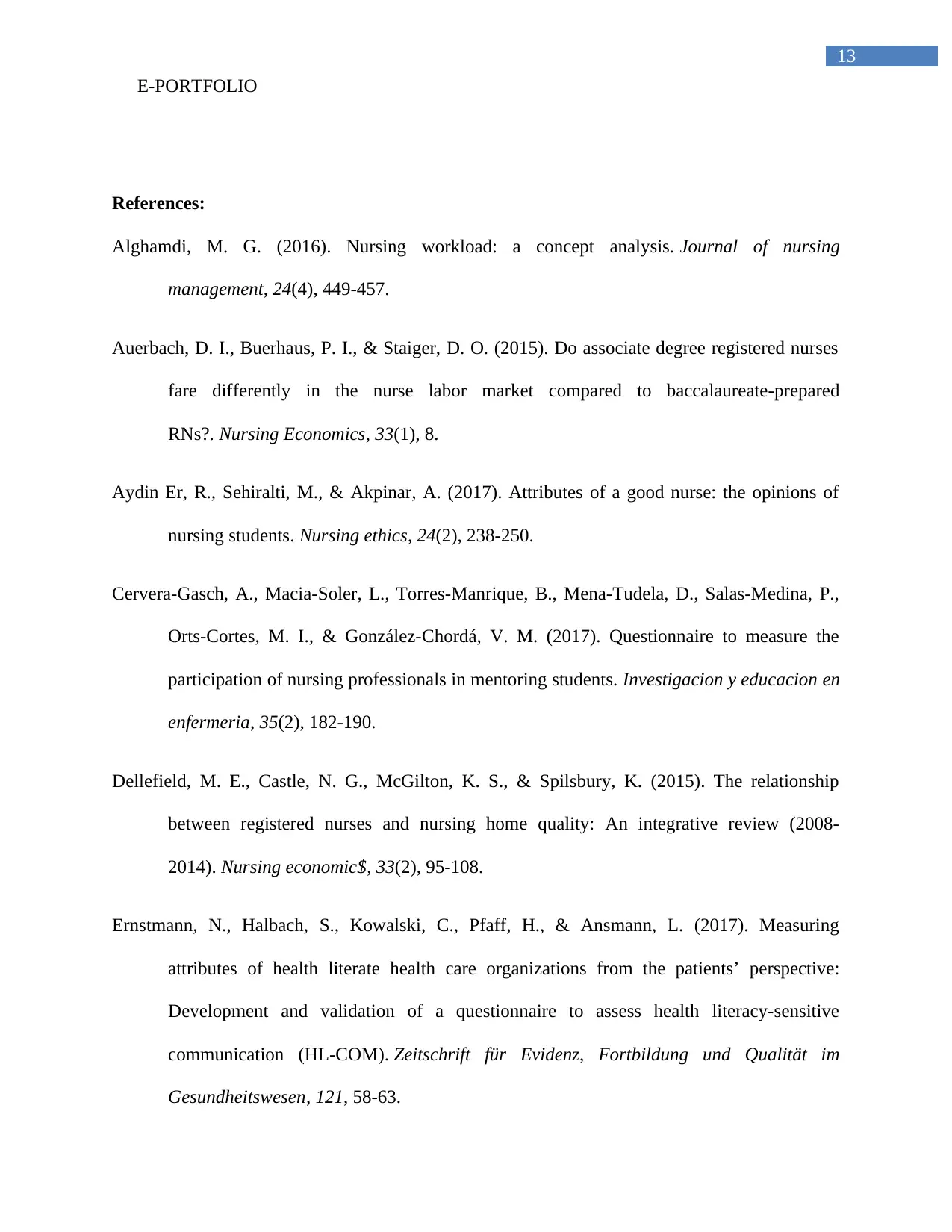
13
E-PORTFOLIO
References:
Alghamdi, M. G. (2016). Nursing workload: a concept analysis. Journal of nursing
management, 24(4), 449-457.
Auerbach, D. I., Buerhaus, P. I., & Staiger, D. O. (2015). Do associate degree registered nurses
fare differently in the nurse labor market compared to baccalaureate-prepared
RNs?. Nursing Economics, 33(1), 8.
Aydin Er, R., Sehiralti, M., & Akpinar, A. (2017). Attributes of a good nurse: the opinions of
nursing students. Nursing ethics, 24(2), 238-250.
Cervera-Gasch, A., Macia-Soler, L., Torres-Manrique, B., Mena-Tudela, D., Salas-Medina, P.,
Orts-Cortes, M. I., & González-Chordá, V. M. (2017). Questionnaire to measure the
participation of nursing professionals in mentoring students. Investigacion y educacion en
enfermeria, 35(2), 182-190.
Dellefield, M. E., Castle, N. G., McGilton, K. S., & Spilsbury, K. (2015). The relationship
between registered nurses and nursing home quality: An integrative review (2008-
2014). Nursing economic$, 33(2), 95-108.
Ernstmann, N., Halbach, S., Kowalski, C., Pfaff, H., & Ansmann, L. (2017). Measuring
attributes of health literate health care organizations from the patients’ perspective:
Development and validation of a questionnaire to assess health literacy-sensitive
communication (HL-COM). Zeitschrift für Evidenz, Fortbildung und Qualität im
Gesundheitswesen, 121, 58-63.
E-PORTFOLIO
References:
Alghamdi, M. G. (2016). Nursing workload: a concept analysis. Journal of nursing
management, 24(4), 449-457.
Auerbach, D. I., Buerhaus, P. I., & Staiger, D. O. (2015). Do associate degree registered nurses
fare differently in the nurse labor market compared to baccalaureate-prepared
RNs?. Nursing Economics, 33(1), 8.
Aydin Er, R., Sehiralti, M., & Akpinar, A. (2017). Attributes of a good nurse: the opinions of
nursing students. Nursing ethics, 24(2), 238-250.
Cervera-Gasch, A., Macia-Soler, L., Torres-Manrique, B., Mena-Tudela, D., Salas-Medina, P.,
Orts-Cortes, M. I., & González-Chordá, V. M. (2017). Questionnaire to measure the
participation of nursing professionals in mentoring students. Investigacion y educacion en
enfermeria, 35(2), 182-190.
Dellefield, M. E., Castle, N. G., McGilton, K. S., & Spilsbury, K. (2015). The relationship
between registered nurses and nursing home quality: An integrative review (2008-
2014). Nursing economic$, 33(2), 95-108.
Ernstmann, N., Halbach, S., Kowalski, C., Pfaff, H., & Ansmann, L. (2017). Measuring
attributes of health literate health care organizations from the patients’ perspective:
Development and validation of a questionnaire to assess health literacy-sensitive
communication (HL-COM). Zeitschrift für Evidenz, Fortbildung und Qualität im
Gesundheitswesen, 121, 58-63.
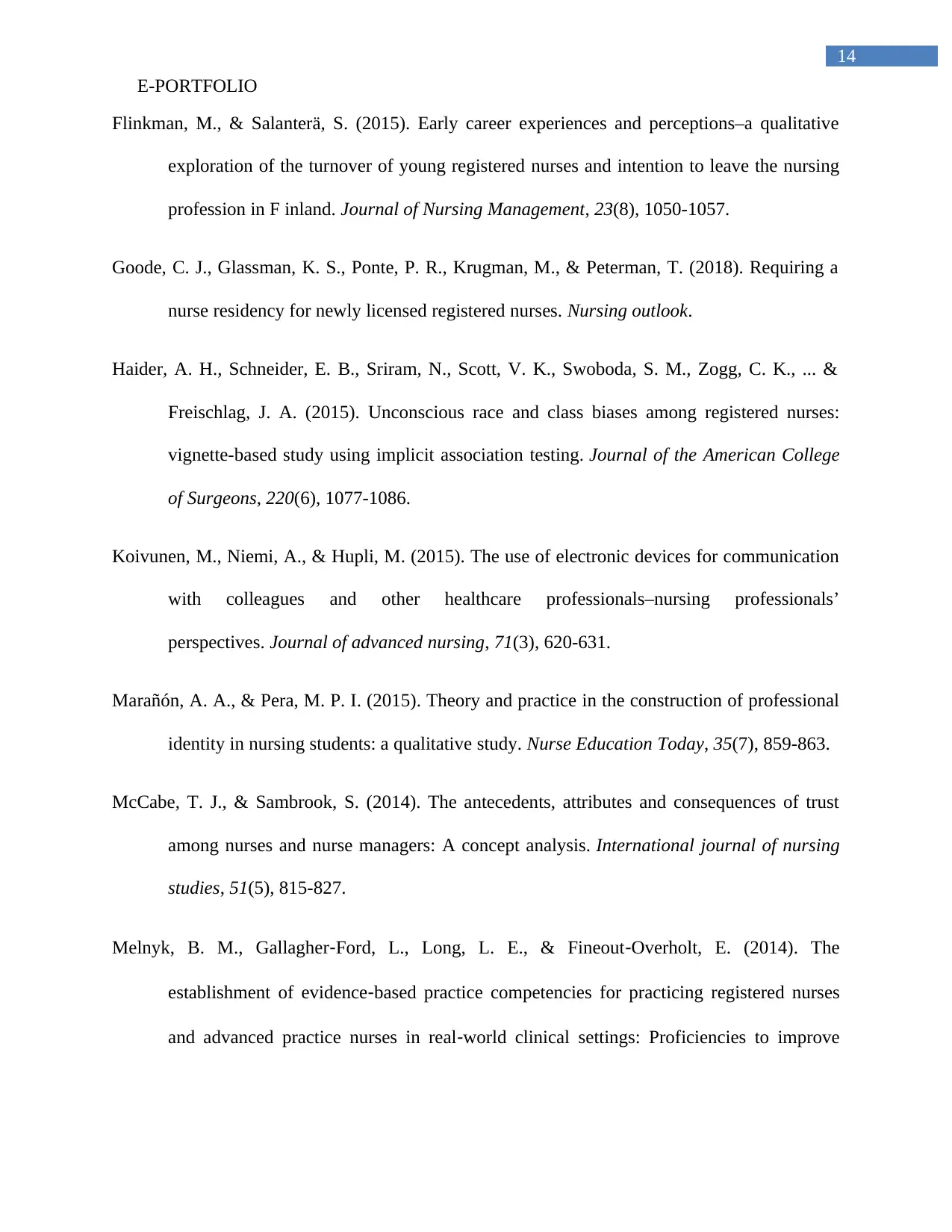
14
E-PORTFOLIO
Flinkman, M., & Salanterä, S. (2015). Early career experiences and perceptions–a qualitative
exploration of the turnover of young registered nurses and intention to leave the nursing
profession in F inland. Journal of Nursing Management, 23(8), 1050-1057.
Goode, C. J., Glassman, K. S., Ponte, P. R., Krugman, M., & Peterman, T. (2018). Requiring a
nurse residency for newly licensed registered nurses. Nursing outlook.
Haider, A. H., Schneider, E. B., Sriram, N., Scott, V. K., Swoboda, S. M., Zogg, C. K., ... &
Freischlag, J. A. (2015). Unconscious race and class biases among registered nurses:
vignette-based study using implicit association testing. Journal of the American College
of Surgeons, 220(6), 1077-1086.
Koivunen, M., Niemi, A., & Hupli, M. (2015). The use of electronic devices for communication
with colleagues and other healthcare professionals–nursing professionals’
perspectives. Journal of advanced nursing, 71(3), 620-631.
Marañón, A. A., & Pera, M. P. I. (2015). Theory and practice in the construction of professional
identity in nursing students: a qualitative study. Nurse Education Today, 35(7), 859-863.
McCabe, T. J., & Sambrook, S. (2014). The antecedents, attributes and consequences of trust
among nurses and nurse managers: A concept analysis. International journal of nursing
studies, 51(5), 815-827.
Melnyk, B. M., Gallagher‐Ford, L., Long, L. E., & Fineout‐Overholt, E. (2014). The
establishment of evidence‐based practice competencies for practicing registered nurses
and advanced practice nurses in real‐world clinical settings: Proficiencies to improve
E-PORTFOLIO
Flinkman, M., & Salanterä, S. (2015). Early career experiences and perceptions–a qualitative
exploration of the turnover of young registered nurses and intention to leave the nursing
profession in F inland. Journal of Nursing Management, 23(8), 1050-1057.
Goode, C. J., Glassman, K. S., Ponte, P. R., Krugman, M., & Peterman, T. (2018). Requiring a
nurse residency for newly licensed registered nurses. Nursing outlook.
Haider, A. H., Schneider, E. B., Sriram, N., Scott, V. K., Swoboda, S. M., Zogg, C. K., ... &
Freischlag, J. A. (2015). Unconscious race and class biases among registered nurses:
vignette-based study using implicit association testing. Journal of the American College
of Surgeons, 220(6), 1077-1086.
Koivunen, M., Niemi, A., & Hupli, M. (2015). The use of electronic devices for communication
with colleagues and other healthcare professionals–nursing professionals’
perspectives. Journal of advanced nursing, 71(3), 620-631.
Marañón, A. A., & Pera, M. P. I. (2015). Theory and practice in the construction of professional
identity in nursing students: a qualitative study. Nurse Education Today, 35(7), 859-863.
McCabe, T. J., & Sambrook, S. (2014). The antecedents, attributes and consequences of trust
among nurses and nurse managers: A concept analysis. International journal of nursing
studies, 51(5), 815-827.
Melnyk, B. M., Gallagher‐Ford, L., Long, L. E., & Fineout‐Overholt, E. (2014). The
establishment of evidence‐based practice competencies for practicing registered nurses
and advanced practice nurses in real‐world clinical settings: Proficiencies to improve
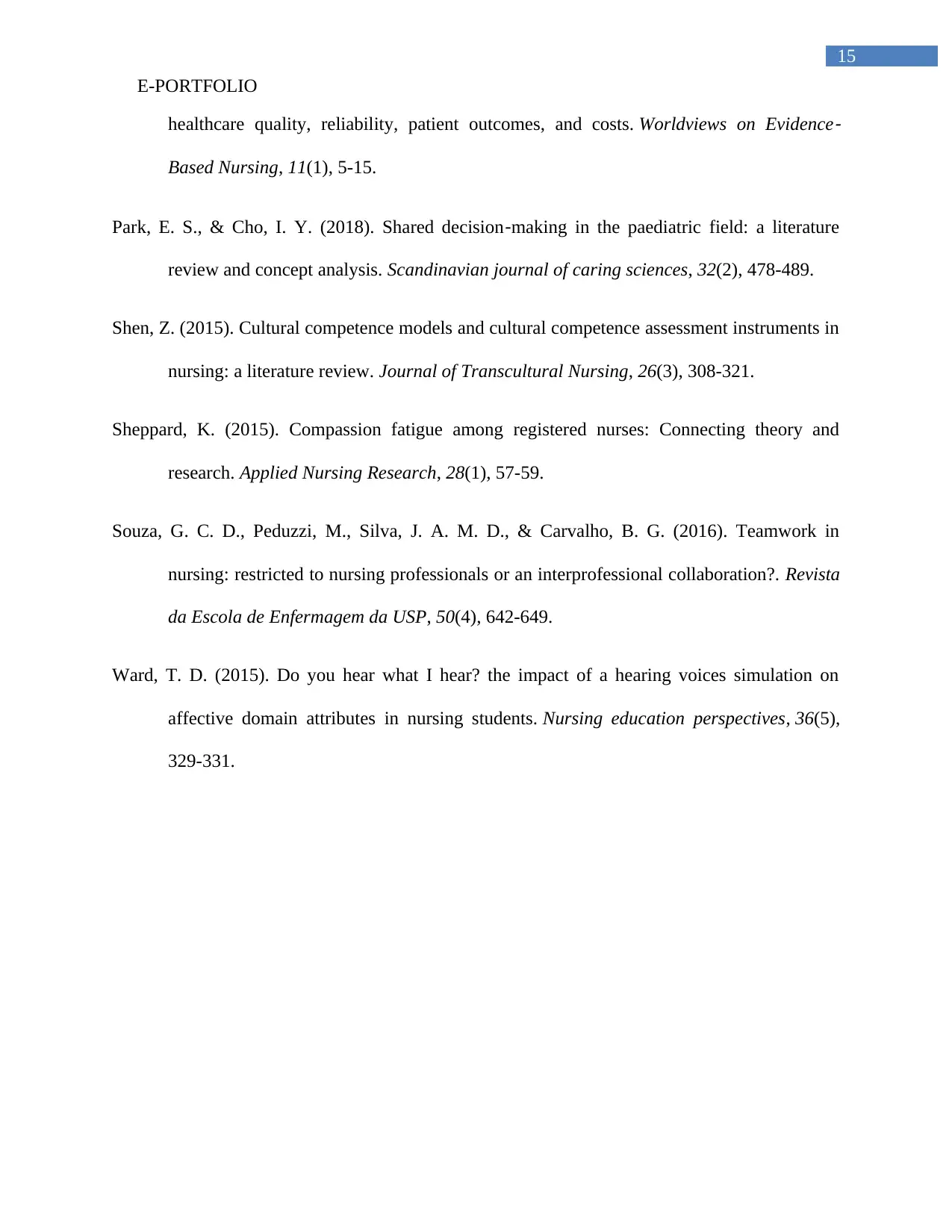
15
E-PORTFOLIO
healthcare quality, reliability, patient outcomes, and costs. Worldviews on Evidence
‐
Based Nursing, 11(1), 5-15.
Park, E. S., & Cho, I. Y. (2018). Shared decision‐making in the paediatric field: a literature
review and concept analysis. Scandinavian journal of caring sciences, 32(2), 478-489.
Shen, Z. (2015). Cultural competence models and cultural competence assessment instruments in
nursing: a literature review. Journal of Transcultural Nursing, 26(3), 308-321.
Sheppard, K. (2015). Compassion fatigue among registered nurses: Connecting theory and
research. Applied Nursing Research, 28(1), 57-59.
Souza, G. C. D., Peduzzi, M., Silva, J. A. M. D., & Carvalho, B. G. (2016). Teamwork in
nursing: restricted to nursing professionals or an interprofessional collaboration?. Revista
da Escola de Enfermagem da USP, 50(4), 642-649.
Ward, T. D. (2015). Do you hear what I hear? the impact of a hearing voices simulation on
affective domain attributes in nursing students. Nursing education perspectives, 36(5),
329-331.
E-PORTFOLIO
healthcare quality, reliability, patient outcomes, and costs. Worldviews on Evidence
‐
Based Nursing, 11(1), 5-15.
Park, E. S., & Cho, I. Y. (2018). Shared decision‐making in the paediatric field: a literature
review and concept analysis. Scandinavian journal of caring sciences, 32(2), 478-489.
Shen, Z. (2015). Cultural competence models and cultural competence assessment instruments in
nursing: a literature review. Journal of Transcultural Nursing, 26(3), 308-321.
Sheppard, K. (2015). Compassion fatigue among registered nurses: Connecting theory and
research. Applied Nursing Research, 28(1), 57-59.
Souza, G. C. D., Peduzzi, M., Silva, J. A. M. D., & Carvalho, B. G. (2016). Teamwork in
nursing: restricted to nursing professionals or an interprofessional collaboration?. Revista
da Escola de Enfermagem da USP, 50(4), 642-649.
Ward, T. D. (2015). Do you hear what I hear? the impact of a hearing voices simulation on
affective domain attributes in nursing students. Nursing education perspectives, 36(5),
329-331.
1 out of 16
Related Documents
Your All-in-One AI-Powered Toolkit for Academic Success.
+13062052269
info@desklib.com
Available 24*7 on WhatsApp / Email
![[object Object]](/_next/static/media/star-bottom.7253800d.svg)
Unlock your academic potential
© 2024 | Zucol Services PVT LTD | All rights reserved.





